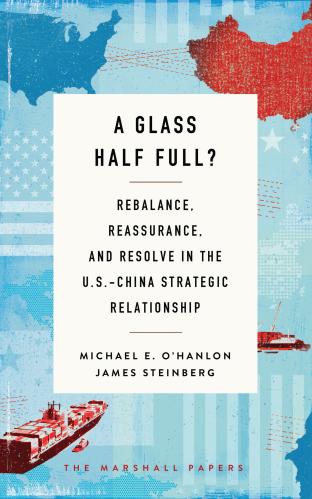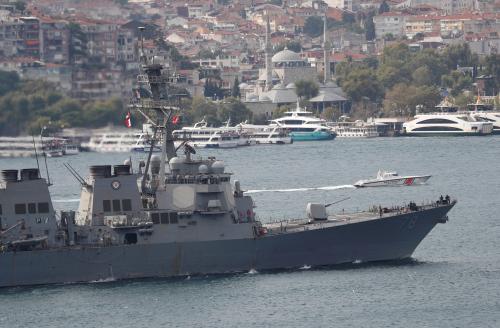Whether Joe Biden or Donald Trump wins the presidential election in November, the United States could soon face a triple-whammy on the defense budget front.
First, nothing has gotten easier about dealing with the threats that existed before the coronavirus struck — from Putin’s Russia to Xi’s China to North Korea, Iran, and terrorism. Second, several new types of threats are more palpable and foreboding than ever, as COVID-19 has revealed; some will require more resources to address. Third, the nation’s fiscal plight is dire. Publicly held debt will likely exceed U.S. gross domestic product (GDP) later this year, and keep growing after that, even with a strong recovery.
In this environment, defense critics will make hay of the fact that at nearly $750 billion, while modest as a percent of GDP, the annual national defense budget exceeds its Cold War average by more than $200 billion in real terms. Some were already calling for cuts of as much as $200 billion in the annual defense budget before the COVID-19 crisis.
As scholars like former John McCain aide Chris Brose have warned, the American armed forces already routinely “lose” to China in combat simulations set in the western Pacific. How can the nation modernize its military, stay vigilant against rising great powers, handle existing challenges, and save some money in the process?
The usual list of suspects can only get us so far in the budget-cutting process. Domestic base closures, if they ever happen again, may save money — but only about $2 billion to $4 billion per year once implemented, and only after costing money in the early years. Reform of the $50 billion per year defense health sector may help, too — but as with most things in health care reform, success is usually measured more by limiting future cost growth than actually cutting budgets. Curtailing the F-35 fighter jet program or delaying the replacement of the nation’s intercontinental ballistic missile force may help some too — but most aircraft purchases and nuclear weapons modernization efforts are needed to replace weaponry or to make the force more resilient against great-power challenges. We need to think bigger.
Fortunately, good ideas are out there, if we get serious about developing and implementing them. Indeed, some are coming out of the Pentagon itself, as I learned last week when interviewing two outgoing members of the joint chiefs of staff.
One bold proposal came from the outgoing chief of staff of the Air Force, General David Goldfein. Several years ago, Goldfein wanted to grow the Air Force by almost a quarter — from 312 squadrons across the active force, Guard and Reserve to a total of 386. He no longer is pushing this agenda. Now, he says he has “plenty of trucks” — that is, plenty of planes — but not enough “highway.” By the latter, he means command and control networks that withstand the efforts of a future China or Russia to jam our electronics, hack cyber systems, cut undersea communications cables, and jam or shoot down U.S. satellites.
In fact, Goldfein is now ready to make some of those 312 squadrons smaller. In a Brookings event in early July, he explained an approach that would eliminate the more expensive planes — call them the lemons (my word, not his) — in various squadrons, and retire those. If we reduced the size of many squadrons say 10% to 20%, some of the savings could be used for modernization; another portion might be returned to the taxpayer. Goldfein did not volunteer a number. But the logic of this approach could make the Air Force — and indeed key parts of all four major military services, since all have air fleets — 5% to 10% less expensive over time. Savings could reach into the low tens of billions a year.
General Joseph Lengyel, the head of the National Guard Bureau, laid out another big idea in another Brookings webinar. Lengyel observed that Army National Guard and Air Force National Guard are far different today from the days when he was first in uniform in the 1980s. They are now much more combat-capable, and no longer just the “hand-me-down” part of the military. With the Air National Guard, units are pretty much ready to go all the time. With the Army National Guard, small units are generally quickly available. Bigger ones, up to and including brigades, can be very good after a few months of preparation.
The Guard and Reserve components of the various services do not save the United States any money when they are activated and deployed. So shifting more force structure to the reserve components only makes sense if the overall military is somewhat less busy than before. However, with the surges in Iraq and Afghanistan long since over, that is indeed the case now, and figures to be the case in the future, too. Today’s military includes about 2.1 million uniformed personnel: 1.3 million and 800,000 reserve component (including Guard and Reserve). If the Guard and Reserve grew from 800,000 to 1,000,000 personnel, with corresponding cuts to the active-duty forces, annual savings might reach $30 billion or so.
Neither of these ideas is going to allow precipitous cuts to the defense budget. But they can help us keep the American armed forces strong — and, importantly, modernize them — in a world where their budgets may stay flat for many years to come. That would allow us to scale back the defense spending burden relative to GDP, gradually bending the long-term cost curves in a way that can help gradually get the nation back to fiscal health — and without risking its national security in the meantime.







Commentary
How to cut (and not cut) the defense budget
July 9, 2020